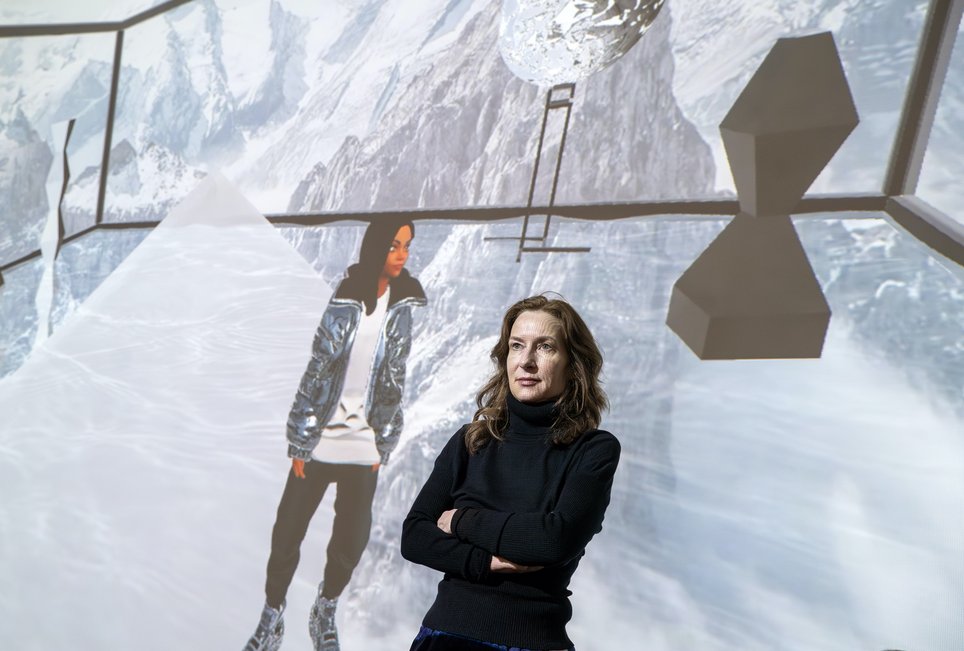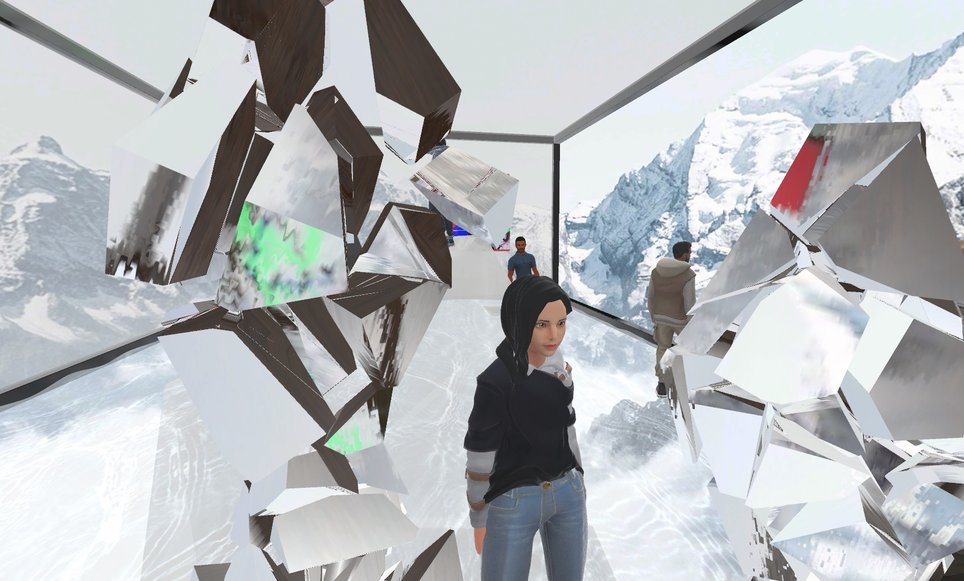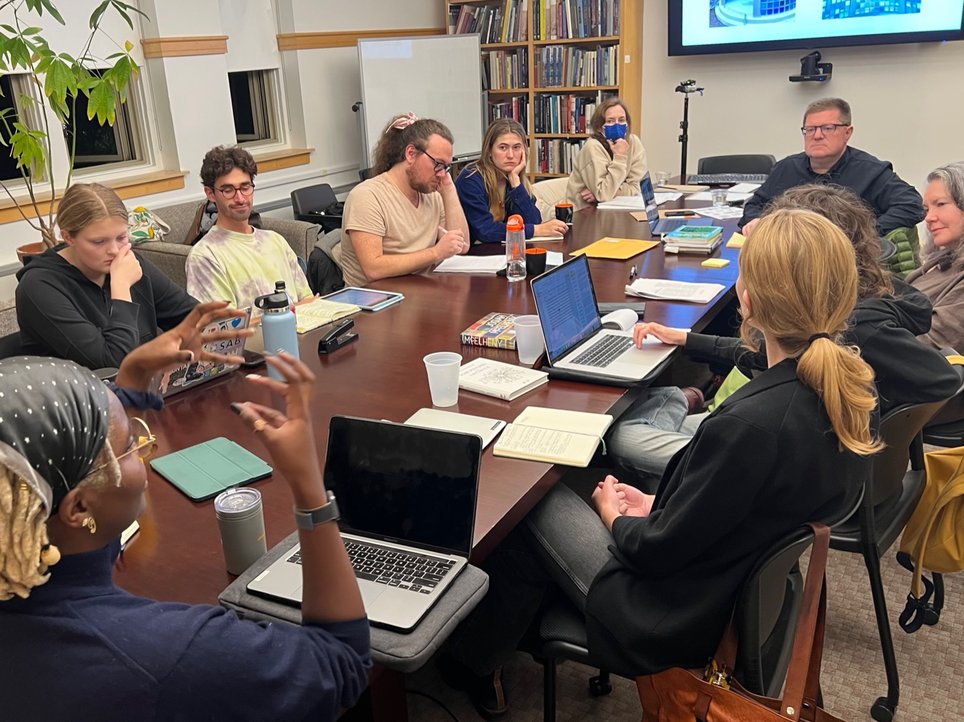Exhibition imagines, engages with “our digital future”
Whereas last week’s snow complicated in-person events, the landscape provided an appropriate backdrop for a virtual discussion on artist Josephine Meckseper’s Scenario for a Past Future, an exhibition that counts among its influences Bruno Taut’s Alpine architecture.
The panel discussion, “Scenario for a Past Future and Avant-Garde Immersive Worlds,” featured Meckseper, architect Hani Rashid, and Daniela Fabricius, assistant professor in architecture at the University of Pennsylvania.
At the event, co-sponsored by the Center for Digital Humanities, panelists offered their reflections on Meckseper’s “interactive media installation,” on view at the Lewis Center’s Hurley Gallery until February 22. A Q&A and conversation followed the presentation.
Meckseper began by introducing Scenario, which she considers “as a research project and experiment with virtual reality.” Viewers of the exhibition do not wear headsets, as in many virtual reality experiences. Rather, they interact with a virtual glass museum-like space that is “transposed” onto the real-life gallery wall.

Artist Josephine Meckseper at the Scenario for a Past Future gallery wall (photo/Jon Sweeney)
Meckseper also discussed the exhibition’s influences, which range from a medieval “rendering” of the world as a sphere to the midcentury German composer Karlheinz Stockhausen, whose music inspired the sound piece that plays during the experience. Early twentieth-century work was particularly important, she said.
Rashid’s presentation contextualized the exhibition within the history of virtual reality for architects.
“Virtual reality is nothing new to spatialists” or to “people creating spatial entities,” he said. Virtual reality and its predecessors have allowed those who engage with them to “conceptualize[] realms that may or may not have been able to exist at the time.”
Rashid also situated Scenario—with its stark, dystopian feel—in contrast to the utopian spaces favored in the COVID-era metaverse.
“There is nothing comforting about [Scenario] from the point of view of escapism,” he added later.
Fabricius closed the presentations by focusing her analysis on three topics: 1) the exhibition’s “multilayered architectural container”; [c1] 2) the question of territory, including the reference to Taut’s Alpine architecture; and 3) capitalism and assets.
Whereas viewers are able to look out of the glass space into the Alps, Fabricius added that glass nonetheless is “a space to contain things.”
During the Q&A, Meckseper also discussed the exhibition’s relationship to capitalism.
She explained that the consumer critique inherent in her previous vitrine works is furthered in this exhibition by inviting the viewer into “a different time zone where we are almost in a post-human realm.” What is left are the “remnants of culture” characteristic of “the capitalist world.”
At the end of the discussion, guests were able to select an avatar to interact with the exhibition virtually on their laptop and engage with the avatars of other guests, making it a social experience.

Avatars stand in the virtual gallery space (courtesy/Josephine Meckseper)
Meckseper said that the making of Scenario of a Past Future in partnership with the digital arts organization DMINTI and Rashid coincided with her preparation for the fall 2022 course she co-taught with exhibition co-organizer Brigid Doherty, associate professor of German and Art and Archaeology, when Meckseper was a Belknap Fellow in the Humanities Council.
According to Doherty, a member of the CDH Executive Council, the course—entitled “Counterworlds: Innovation and Rupture in Communities of Artistic Practice”—“explored the dynamics of creative collaboration through case studies of utopian communities of artistic practice in twentieth-century Europe and the US and considered how those experiments related to theories of modernity and futurity.”
Added Meckseper: “The more I thought about it—looking at the historical precedents for early all-encompassing environments [e.g. theater in the early twentieth century]—the more it started making sense to me to create something that could reference these early twentieth-century models.”
During the course itself, Doherty explained, students engaged with “how utopian and dystopian ideas have emerged historically, and brought critical perspectives to bear on concepts of utopia and related ideas about historical time (pasts and futures real and imagined). Josephine’s work at that time on Scenario for a Past Future informed her incredible contributions to the course and gave students a glimpse of the integration of critical and artistic practices that has been a hallmark of her work over the past three decades.”

Artist Josiah McElheny was among several guests who visited Meckseper and Doherty’s course (photo/Kirstin Ohrt, Department of Art & Archaeology)
Doherty added that her participation in the CDH’s Humanities + Data Science Faculty Institute last year “shaped my thinking about Scenario for a Past Future as a work of art and an experiment in the design of immersive digital architecture and helped me generate fresh ideas around the possibility of installing a new version of the work at Princeton.” Plans for the exhibition eventually came together through a collaboration with Jeffrey Whetstone, Professor of Photography and Director of the Program in Visual Arts.
Doherty, who was joined at the Institute by graduate student Sara Green (Art and Archaeology), said she “benefited from the opportunity the Institute offered to engage in conversations with colleagues doing research at the intersection of the humanities and data sciences while working to develop our own critical perspective on present-day technologies for the design of virtual worlds and the production, exhibition, and exchange of various forms of digital art.”
Scenario too “invites questions about the dystopian elements of virtual reality,” Meckseper noted at last week’s event.
Visitors are invited to consider the “potentially apocalyptic scenario” presented in the exhibition—a scenario that is “no longer in the present tense,” she explained—“and how we actually define the Virtual, and whether we are not instead dealing with a second-order materiality.”
At the same time, according to Meckseper, Scenario of a Past Future is an “imaginary space in which people can explore and engage with the immersive architecture, artworks and sound collectively,” offering a “humanistic route” of interpretation. “As the title suggests, I was interested in creating a type of virtual classroom and social place, to experience and discuss past historical concepts and to develop new future perspectives.”
Explained Rashid: Virtual reality can allow us to “explore the utopian on a quest for a deeper understanding of the human condition itself.”
“I’m addressing our digital future at the same time I’m creating this work in the present,” Meckseper said.
The exhibition Scenario for a Past Future is presented by the Program in Visual Arts and the Department of Art & Archaeology. The exhibition and the panel discussion, “Scenario for a Past Future and Avant-Garde Immersive Worlds,” were co-organized by Brigid Doherty and Jeffrey Whetstone in collaboration with Josephine Meckseper, with technical assistance from Joe Arnold of the Lewis Center for the Arts and Sam Hillmer and Jacqueline Sischy of DMINTI. The panel discussion was co-sponsored by the Department of Art & Archaeology, Program in Visual Arts, Humanities Council, Center for Digital Humanities, and Program in Media+Modernity.
Carousel photo: Jon Sweeney